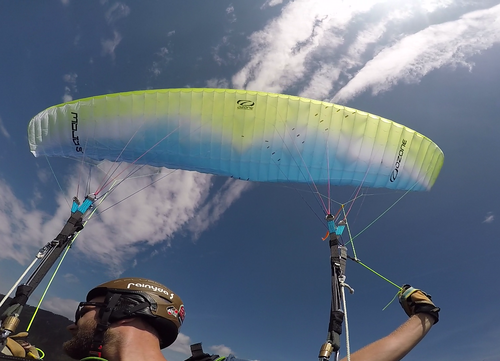OZONE Mojo 5 M |
|||||||||||||||||||||||||||||||||||||||||||||||||||||||||||||||||||||||||||||||||||||||||||||||||||||||||||||||||||


|
|||||||||||||||||||||||||||||||||||||||||||||||||||||||||||||||||||||||||||||||||||||||||||||||||||||||||||||||||||
Instability rating |
|||||||||||||||||||||||||||||||||||||||||||||||||||||||||||||||||||||||||||||||||||||||||||||||||||||||||||||||||||
|
|||||||||||||||||||||||||||||||||||||||||||||||||||||||||||||||||||||||||||||||||||||||||||||||||||||||||||||||||||
Glider characteristics |
|||||||||||||||||||||||||||||||||||||||||||||||||||||||||||||||||||||||||||||||||||||||||||||||||||||||||||||||||||
|
Launch preparations: easy
launch characteristics: balanced, climbs constantly, no guidance necessary, good feedback during inflation, little braking required, slows before zenith, control check simple, low takeoff speed
asymmetric collapse: moderate dynamics, total course change 90-180°, (1), moderate course change rate, moderate forward pitching 45-60°, (2), moderate height loss 30-39 m, (2), low sink velocity 10-14 m/s, (1), G-Force < 2,5 G, (1)
Frontal collapse: canopy collapses with low total collapse area, moderate pitch backwards 30-45°, low pitch forwards <30°, low dynamics, no course change, (1), recovery usually immediate, symmetric recovery, immediate return to normal airspeed, moderate height loss 30-39 m, (2), very low sink velocity <10 m/s, (1)
Spiral dives: rapid sink velocity increase, Moderate G-Force 3,5- 4.0 G, (2), Sink velocity after 720° <18 m/s, (3), High maximum sink velocity < 22 m/s, (3), sink velocity increase < 6 m/s on brake release, (2), Course change 540-720° after spiral exit, (4), Very high height loss during recovery >100 m, (4)
B-Stall: normal force required, marked pitch backwards 30-45°, low pitch forwards <15°, stable sink phase, no tendency to deform, immediate return to normal airspeed, 8-10 m/s, height loss on recovery 20-40 m
big ears: simple initiation, stable flight phase, immediate automatic recovery, Vsink unaccelerated 2,5-3 m/s, Vsink accelerated 3,5-4 m/s, Vunaccelerated 3-5 km/h less than trimspeed, Vaccelerated 0-3 km/h faster than trimspeed
Steering behaviour: agile, 70 cm brake travel range, Noticable brake pressure increase, Late stall point, easily identifiable |
|||||||||||||||||||||||||||||||||||||||||||||||||||||||||||||||||||||||||||||||||||||||||||||||||||||||||||||||||||
Notes |
|||||||||||||||||||||||||||||||||||||||||||||||||||||||||||||||||||||||||||||||||||||||||||||||||||||||||||||||||||
|
TakeOff The glider is easy to prepare. The lines and risers are easy to check. The colour of the A-Lines is different to the colours of the A-Riser. After the impuls of the pilot, the glider climbs nice and without any additional pilotsupport. The glider slows down by it self above the pilot. Just a tiny brakeinput is necessary to slow the glider down above the pilot. Air For an A-Glider the wing shows a agile handling. In thermals and turbulences the wing shows a little tendency to pry. Asymmetric Collapse Glider shows a calm pitch behavior. Sometimes the pitch was less than 45°. Very big collapses cause a pitch of maximum 60°. The complete turn of the glider is less than 100°. Shock reinflations do not cause additionaly dynamic. Front Collapse It was not possible to do surface deep collapses. Only <60%. Bigger collapses can lead to a different behavior than in this test. Opening was most of the time very fast. Somtimes the glider starts to open in the middle, slowly followed by the wingtips. This leads to a bigger loss of altitude. Spiral It is easy to get into the Spiral with this glider. If the Pilot does not act against the g-force, the glider shows a fast exit during 270°. There is a very thin line between stable spiral and self-sufficient exit at the maximum wingload. If the Pilot puts the weightshift a little bit in a neutral position the glider continued turning and accelerated up to 22m/s. B-Line-Stall If the lines are pulled to their maximum, the glider gets a bit nervous. No tendency for deformations. BigEars Easy. |
|||||||||||||||||||||||||||||||||||||||||||||||||||||||||||||||||||||||||||||||||||||||||||||||||||||||||||||||||||
Rating |
|||||||||||||||||||||||||||||||||||||||||||||||||||||||||||||||||||||||||||||||||||||||||||||||||||||||||||||||||||
|
Safety class 4 This class of paraglider reacts demandingly to one or more of the following manoeuvres: frontal collapse, asymmetric collapse or spiral dive.Demandingly means that the above manoeuvres result in marked dynamic reactions from the glider and/or large height losses. Advanced piloting skills which need to be regularly practised, together with good personal reaction times are required to safely fly this class of gliders. Basic recovery techniques for ending a manoeuvre are not sufficient to maintain control, reduce height loss to a minimum and prevent subsequent critical reactions. Pilots should be able to recognise the onset of the above manoeuvres and be able to prevent or minimise their effects through immediate and precise pilot inputs. Additional experience such as regular ground handling and SIV training is required to safely fly gliders of this class. Special training or pilot skills which exceed standard training may be required for the safe performance of emergency descent techniques. Gliders of this Safety Class are not suitable for beginners, irregular flyers or low-airtime pilots. |
|||||||||||||||||||||||||||||||||||||||||||||||||||||||||||||||||||||||||||||||||||||||||||||||||||||||||||||||||||

